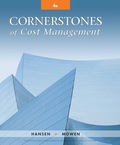
Southward Company has implemented a JIT flexible manufacturing system. John Richins, controller of the company, has decided to reduce the accounting requirements given the expectation of lower inventories. For one thing, he has decided to treat direct labor cost as a part of

The predetermined conversion cost rate is based on available production hours in each cell. The radiator cell has 45,000 hours available for production, and the water pump cell has 27,000 hours. Conversion costs are applied to the units produced by multiplying the conversion rate by the actual time required to produce the units. The radiator cell produced 81,000 units, taking 0.5 hour to produce one unit of product (on average). The water pump cell produced 90,000 units, taking 0.25 hour to produce one unit of product (on average).
Other actual results for the year are as follows:

All units produced were sold. Any conversion cost variance is closed to Cost of Goods Sold.
Required:
- 1. Calculate the predetermined conversion cost rates for each cell.
- 2. Prepare journal entries using backflush accounting. Assume two trigger points, with completion of goods as the second trigger point.
- 3. Repeat Requirement 2, assuming that the second trigger point is the sale of the goods.
- 4. Explain why there is no need to have a work-in-process inventory account.
- 5. Two variants of backflush costing were presented in which each used two trigger points, with the second trigger point differing. Suppose that the only trigger point for recognizing
manufacturing costs occurs when the goods are sold. How would the entries be listed here? When would this backflush variant be considered appropriate?
Want to see the full answer?
Check out a sample textbook solution
Chapter 11 Solutions
EBK CORNERSTONES OF COST MANAGEMENT
 Cornerstones of Cost Management (Cornerstones Ser...AccountingISBN:9781305970663Author:Don R. Hansen, Maryanne M. MowenPublisher:Cengage Learning
Cornerstones of Cost Management (Cornerstones Ser...AccountingISBN:9781305970663Author:Don R. Hansen, Maryanne M. MowenPublisher:Cengage Learning
